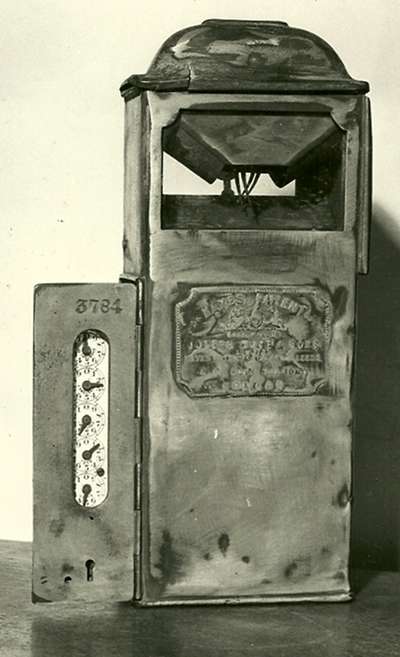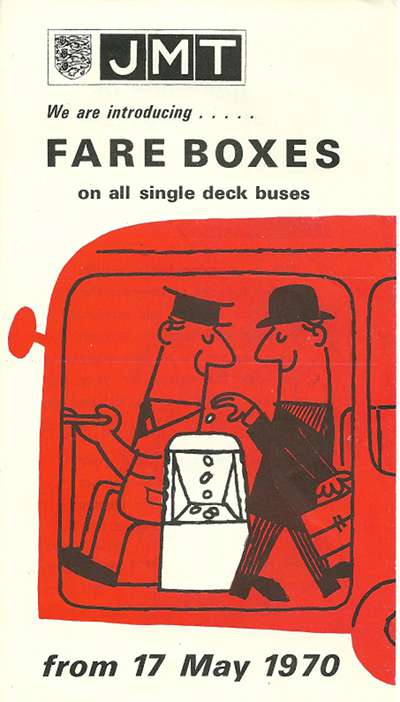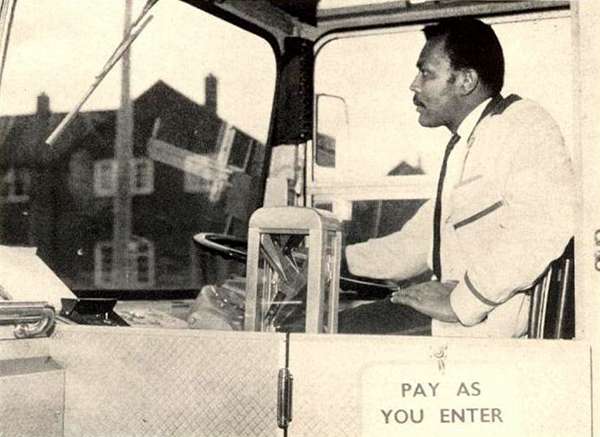A Kind of Money Jar
A Kind of Money Jar
Please can anyone shed some light on a subject for me. I have tried researching about a kind of money jar for want of better wording. It was a kind of ticket machine but with a glass jar for holding the coins that I seem to vaguely remember from the Yorkshire Traction bus I used to catch with my mum as a kid in the early 70's. Please confirm that I have not conjured this up in my imagination. Any help would be greatly appreciated. Thanks.
Chris Jepson
07/04/12 - 15:53
Chris, the money jar you recall may have been a farebox machine. They were used in an effort to speed up boarding times on driver only buses back in the 70's in some areas, but were not universally popular with passengers. Usually the exact fare was demanded, and if a passenger's only available coinage exceeded the fare, no change was given. Okay if you were a local and knew the fare, but to outsiders they must have seemed very unwelcoming beasts!
Brendan Smith
08/04/12 - 08:36
Ashton also used this system which was possibly called the Johnson farebox.
A refinement of this was the Videmat machine which took a photocopy of the proffered coins which was reproduced on the back of the ticket. The system was very prone to problems and quickly fell from favour It was used by Lancs United and South Yorks PTE, again as far as I recall no change was given
Chris Hough
08/04/12 - 09:44
Yes, almost certainly a farebox machine. Amongst the municipal / very urban operators these were seen as the way forward in fare collection in the early 1970s. I seem to think that Sunderland had a scheme, although everything north of Gloucester now merges into "up there" for me. At the 1972 Symposium on Public Transport the G.M. of Huddersfield offered three good reasons to employ this type of fare collection on flat fare services. Much quicker boarding time, easier accounting (the driver did not have to cash up) and much safer the money went straight into an on board "safe" and potential theft would be eliminated. To work as planned no change would be given which, as the paper stated, "would be a huge public relations exercise". It is also interesting to read, that way back in 1972 the paper was looking to "payment being made before boarding" as the real way to speed up boarding times.
David Grimmett
08/04/12 - 10:55
Southend Corporation used the Videmat system in the 1960s/70s, no doubt a valuable aid to timekeeping on their enormous and impressive new Fleetlines. I have to confess to doing a childish experiment with a friend during one week's holiday by paying with the maximum number of low denomination coins that we could muster in a bid to acquire "The World's longest bus ticket." If only we'd kept a few of them for posterity. Incidentally Southend Corporation (proper) was one of my all time favourite and greatly admired operators - at a time when many were reducing or eliminating intermediate destination blinds they increased their already first class ones from three locations to six !!
Chris Youhill
08/04/12 - 16:08
...as, Chris Y, should any self-respecting and helpful bus company at a tourist venue! Portsmouth Corporation was good with its blinds, but the common, but, confusingly, not universal system of having, for example, route 17 one way and 18 coming back for the same route, was taxing, to say the least, for holidaymakers at their first visit!
Chris Hebbron
10/04/12 - 06:34
Re the above mentioned item, I recall there was a similar method of fare-collection on the Cardiff Corporation trolley buses, if my memory is not playing me up. It was fixed permanently at the back of the rear platform near the conductors stand point, and therein lies a question, I cannot remember if they were manned with a conductor, something about them being honesty boxes rings a bell, (excuse the pun. My cousin and I used to board them in Cathedral Road and they terminated at Pier Head, can I remember route number, yes it was the 6 I believe, as 9/10 yr old boys we used to love the terrific acceleration of the electric power, its what Mr Clarkson calls "torks", but we were not really that informed, but they were magnificent buses to behold, big 6 wheelers in that maroon and cream livery, the term "whispering giants" suited them well, I recalled it years later when the Bristol Britannia first flew, that is the nickname they received.
Dave Knapp
03/10/14 - 07:10
Manchester (or SELNEC as it had by then become) had these on the Mancunians when I was at University there in the early 1970's. The receptacle the coins went in was a rectangular metal frame with glass sides about 8 or 9 inches tall. The driver could see the money through the glass and would press a lever which operated a flap in the bottom of the 'jam jar' when he had examined it. That was the theory anyway. Students boarding would sail past at a rate of knots, dropping coins as they passed and certainly faster than they could be examined; whatever the theory I don't think the driver could have had the slightest idea what was going in the machine. They must have been prone to getting all sorts of foreign coins. There was, of course, no record of where you had boarded or how much you had paid. Some routes at the time were 'flat fare' (6d I think) but I don't recall if it was just on those routes that the jam jars were used.
The wonderful thing was that, if you dropped your coin sideways into the hinge of the flap just as the driver operated it to accept the last fare, if you were lucky it would jam the flap and the whole bus had to be taken out of service. You would sail past all the stops only stopping to set down. Good way of speeding the journey up if needed. I have to say I only managed it once.
Peter Cook
03/10/14 - 11:37
This exact-fare-in-the-box-no-change-no-ticket system was in operation at SELNEC when I briefly worked there as a Schedules Clerk in the early 1970's. Apart from the problem of people just dropping anything in the box and shooting past quickly, with then no ticket to show what they'd paid or where they were going, the other concerned what happened when passengers didn't have the correct fare.
As I recall the idea was that if someone had, say, only a pound note they would give it to the driver - who had a float - and he would give them a poundsworth of change from which the passenger could then insert the correct fare in the box. However, passengers would assume that the driver would have deducted the fare which he would then put in the box himself, so they would take the whole poundsworth of change and walk on. So after a while unscrupulous drivers began to go along with this and deducted the fare from their change - but put it elsewhere than in the box ! It was widely acknowledged - by the staff and even their trade union representatives on the quiet - that many of them were making an absolute fortune out of this scam, and the PTE were losing revenue big time.
In the end it was agreed with the trade union that for a trail period one route - I think it was the 60 Higher Blackley Circular - would be converted back to a conventional system with a number of modified, dedicated buses to see what happened. One of my schedules colleagues - it may even have been John Hodkinson - had the task of rescheduling the bus workings to isolate the buses that worked on that route so that they didn't operate anywhere else, and that no buses came off other routes to do the odd trip, as sometimes happened. Predictably, in the first week revenue on the 60 went through the roof ! I left shortly afterwards, but I believe that the trial became permanent and was quickly rolled out throughout the entire operation. It was a scandal that the previous system had ever been allowed in the first place, those that devised it hadn't thought it through and must have been extremely naive.
John Stringer
03/10/14 - 17:33
I think the route was actually the 26 (Cannon Street-Moston) on which most of the buses worked only that route and shared little with other routes. The telling thing was that it was never disclosed what the revenue increase was when the Sablocs were replaced with Almexes, just a msssive order for Almex machines as quickly as possible!
Many were the stories about fareboxes. At one machine tool factory served by a number of works buses, illicit 'Sabloc fishing rods' were being supplied to drivers which could be used to stop money falling into the vault. At one garage, a number of drivers were found wearing rings with a 5p welded to them which could be used to give the impression to passengers that he was putting their fare in the box. Even a Securicor driver transferring money from a depot was caught helping himself to some of the load he was carrying!
The final one was that when a stores lorry left Queens Road Garage carrying the now redundant fare boxea, a choir of drivers gathered outside singing "Will ye no come back again?'
An incidental problem was that on some buses, the farebox could fill up in the day and so a man with a van had to be employed to get around certain buses during the day to empty the box.
John Hodkinson
04/10/14 - 06:44
John, I'm sure you'll be right about it being the 26 and not the 60 - it is several light years ago now !
John Stringer
04/10/14 - 06:46
As Peter and John have indicated, the farebox system soon displayed its inadequacies in operation. London Transport and London Country flirted with the farebox, and yet another aspect of its shortcomings quickly became apparent. There arose a strong suspicion in LCBS management circles that the quantity of cash extracted at the end of the day from each farebox money container, known as the 'coin vault', was rather less than that contributed by the passengers. In theory, the mechanism was tamper proof. Each vault had a sliding shutter on the top surface that was held securely in place by a strong spring that locked the lid in the closed position. As an empty vault was slipped into the farebox machine, the locking device was freed and the lid was pushed back to the open position, ready to accept the takings from the passengers. At the end of the day, withdrawing the vault from the machine resulted in the shutter springing back and locking in the closed position. The Coin Vault Handlers (yes, there was actually a grade created for the purpose) worked late at night when the last bus had run in. They took the full vaults to a secure storage point in the garage from which the Depot Office staff removed them for emptying and counting the following morning. The company's internal auditors took to concealing themselves in parked buses at night to observe the goings on by the Vault Handlers. It soon emerged that these canny individuals, when placing an empty vault in a farebox machine, had found a way of preventing the shutter locking device from working. As the vault was inserted, the lid would begin to slide back, allowing an obstruction to be fitted to the front edge of the shutter. This prevented it closing fully so that when the full vault was taken out at night the lid was not locked in the closed position. Unscrupulous handlers could then pull back the shutter of a full vault and dip into the contents. After helping themselves, the handlers would remove the blockage material, allowing the shutter to spring back and lock in position, with no evidence of tampering being discernible. It goes without saying that, once this skulduggery was detected, the farebox system was quickly abandoned by London Country.
Roger Cox
05/10/14 - 08:52
Fare boxes are nothing new.

They were used in the early days of Tram and Bus operation to stop Conductors 'pocketing' the revenue. An early design was the "Kaye's Farebox".
Stephen Howarth
07/10/14 - 06:24
The mainland was not the only preserve of Farebox Operation.
Jersey Motor Transport introduced them on all their single deck OMO buses (JMT never had OMO double deckers) on 17th May 1970.

A leaflet is attached showing a jolly businessman (probably a Banker, being in the Tax Haven of Jersey) and an equally jolly Driver, thinking of the money he can make out of the new system (perhaps that is unfare - pun, and incorrect spelling intended).
Leaflets showing cartoon type caricatures was all the rage at one time. Would Best Impressions use them today?
Stephen Howarth
09/10/14 - 10:05
Is the JMT passenger smiling because, in typical Farebox fashion, he's just relieved himself of 7 small-denomination coins for his fare? And in what sense was the JMT network - rural, low-frequency (?), significant tourist usage in-season, single-door/under-floor buses - ever suited to this system of fare collection?
Philip Rushworth
12/10/14 - 09:31
Oldham Corporation was another of the North West municipals to go with the Farebox, with them lasting in to the SELNEC era.
They had both the Johnson Box, and what was called the Bolton Box, because it had been produced by that undertaking.
Both used the same 'Jam Jar' top, but whereas the Johnson Box was rectangular the Bolton Box was round.
As John says Drivers had a coin, usually a 5p (did not want to be too greedy) soldered/welded to the back of a ring. The practice was to change the note and hand the change to the passenger, then show them the coin in his hand, turn it over and bang the top of the coin box so that it sounded like the coin had dropped in to the machine.
As for the vaults getting full during the day (so there must have been some revenue coming in) Oldham's practice was to send a man with a trolley down in to Wallshaw Place - commonly known as 'The Grotto' - where all the buses past through. This was full of empty vaults, and as buses past through, the vault changed. The amazing thing about this was that the trolley was just left unattended, as the man moved between stands, and as time went on the trolley got loaded with full vaults, AND it never got touched/robbed. What a different time that was.

I have attached a picture of Driver Frank Blades, at Holts Terminus with a Johnson Fare Box. The black box type instrument to the left of the picture is the passenger counter for the top deck which were operated by 2 steps on the staircase. These were notoriously inaccurate, because kids used to jump over one to show a passenger getting off instead of on, and visa versa.
Stephen Howarth
Comments regarding the above are more than welcome please get in touch via the 'Contact Page' or by email at obp-admin@nwframpton.com
All rights to the design and layout of this website are reserved
Old Bus Photos from Saturday 25th April 2009 to Wednesday 3rd January 2024